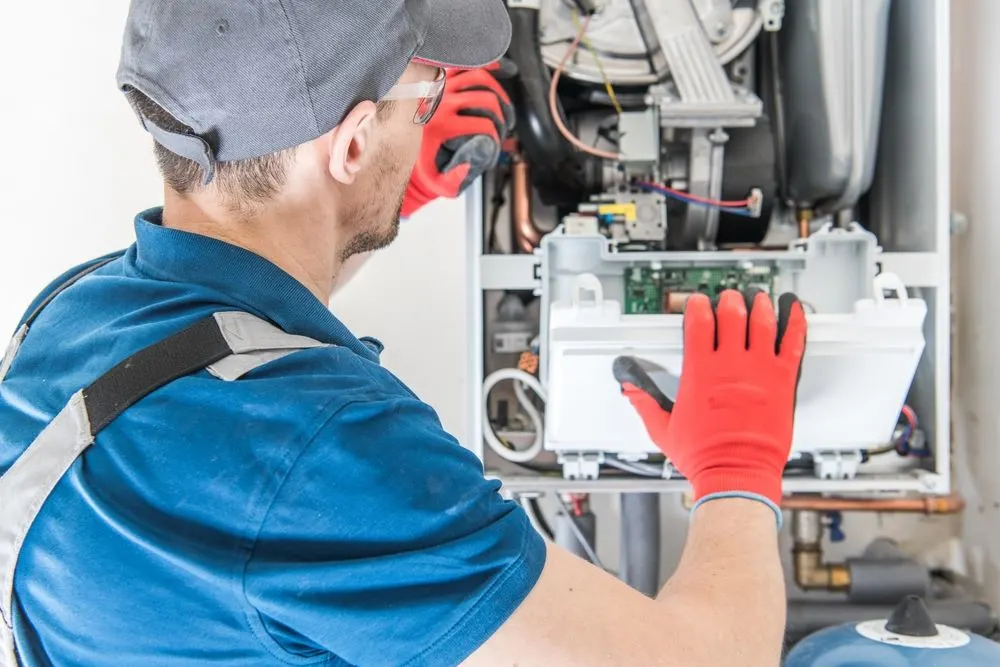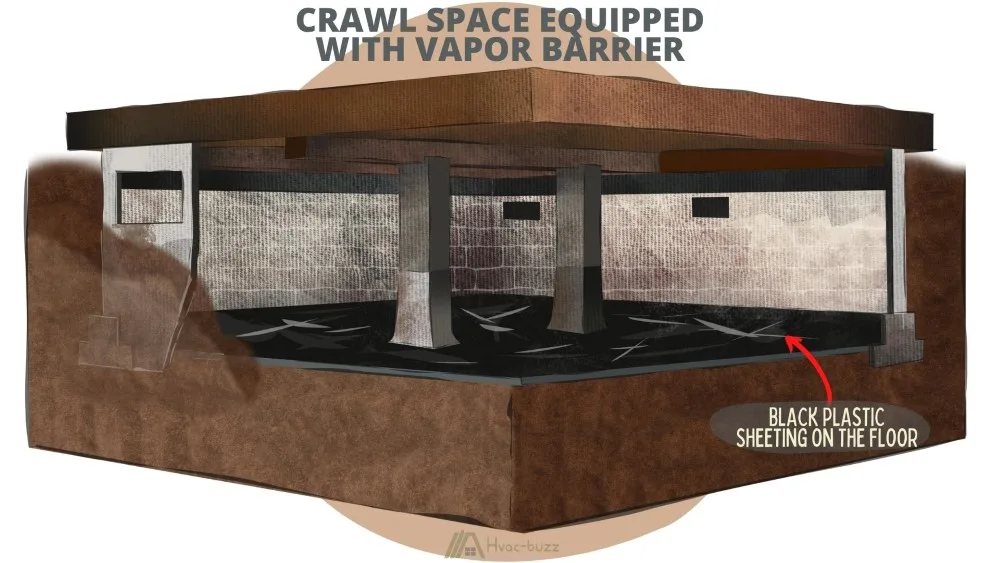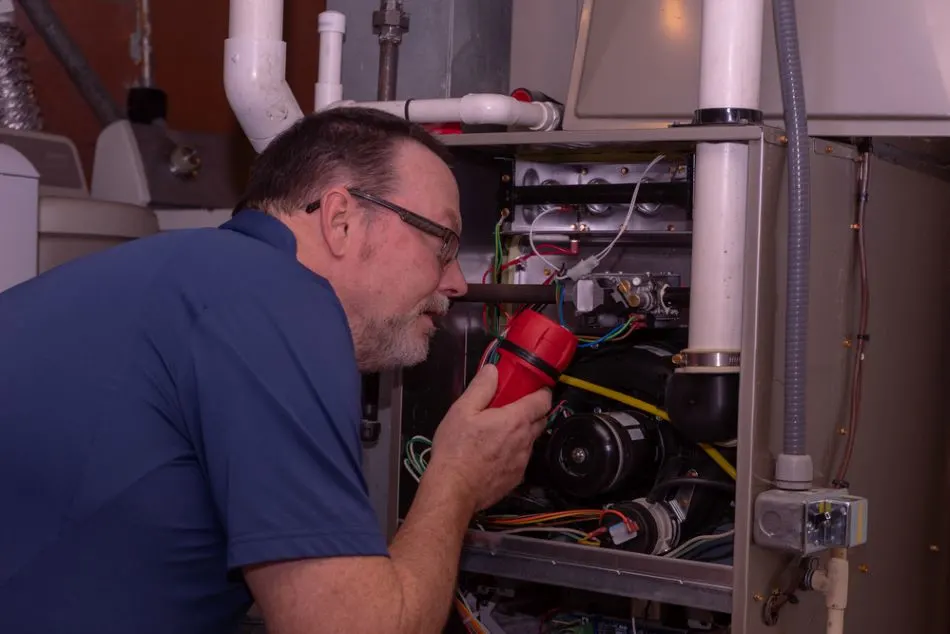Most modern homes have a furnace installed somewhere in the house to provide heat which is then piped throughout the house to supply warmth during the colder months of the year. A furnace is generally installed in a large space like a basement, a utility room, or a garage, but sometimes, it can be installed in smaller areas, depending on the design and size of the house.
As a crawl space is located beneath the floor of your house, always refer to the International Residential Codes for the correct safety requirements before your begin the installation. Furthermore, you should consult your local codes for local requirements. They are likely based on the IRC, but if any amendments have been made, these always supersede the IRC.

A crawl space is the ideal out-of-the-way location for a furnace as it provides fresh air and natural ventilation. To be a code-compliant location, the crawl space should provide easy access for the regular maintenance of the furnace and should be installed according to local codes and industry standards, and regulations.
Furnace In Crawl Space: What Does The Code Say?
Chapter 14 of the International Residential Code discusses the regulations that apply to heating and cooling equipment and appliances. In particular, the code stipulates the approved sizing methods of the appliance, the size and location of the installation area, any floor hazards, and access to the space.

While the regulations do not prohibit installing a furnace in a crawl space, Section M1401.1 does recommend that the furnace be installed according to the manufacturer’s specific instructions.
Access Rules
Section M1401.2 and Section M1408.4 of the IRC discuss access to the furnace.
The code states that all heating and cooling equipment placement and location should allow easy access to these appliances for servicing, replacement, and maintenance purposes.
Before installing a furnace in a crawl space, the following access must be confirmed:
- The opening in the foundation is not less than 18″ by 24″ (457 mm by 610 mm).
- The trap door opening is not less than 22″ by 30″ (559 mm by 762mm).
- The opening and room space should be big enough for an unrestricted working area for maintenance and the replacement of parts.
Location, Clearance, And Installation Requirements
Central Furnaces
Section M1402 of the IRC stipulates the standard to which central furnaces must conform, namely American National Standards Institute ANSI codes UL 727 for oil-fired furnaces and UL 1995 for electrical furnaces.
The IRC also states that the combustion air opening of the furnace should not be obstructed. There should be a clear space of not less than 6″ (152 mm) in front of the opening.

Section M1408 of the IRC specifically discusses the regulations for oil-fired vented floor furnaces. ANSI UL 729 should be complied with, and the manufacturer’s instructions should be followed to ensure the correct clearance and easy access to the equipment.
Floor Furnaces
Section M1408.3 specifies the requirements for the location of the floor furnace:
- Floor and wall registers of the furnace should be installed not less than 6″ (152 mm) from the wall or the adjoining wall.
- The furnace register should be installed not less than 12″ (305 mm) from doors and combustible items and not less than five ft (1.523 m) under flammable materials.
- The furnace burner should not be installed on a concrete floor or within 12″ (305 mm) of an opening door.
Section M1408.5 defines the installation requirements of the floor furnace:
- The thermostat controlling the furnace should be located in the same room as the furnace register.
- The furnace should not be supported from the ground and should be independent of the floor register.
- The furnace should be installed not less than 6″ (152 mm) from the ground and sealed to prevent water entry. The minimum ground clearance should be no less than 2″ (51 mm)
- When excavation is required for a floor furnace installation, it shall extend 30″ (762 mm) beyond the control side and 12″ (305 mm) beyond the remaining sides of the furnace.
For more information, you can check out my Furnace Clearance Guide.
The Floor Must Be Fire Protected
There is a specific regulation in the IRC relating to the fire protection of floors. IRC R302.13 states that the floor assembly above the furnace should be protected.
The underside of the floor assembly should be:
- a ½” (12.7 mm) gypsum wallboard membrane, or
- a 5/8″ (16 mm) wood structural panel membrane, or
- the equivalent approved fire-proof material.
The exception to the regulation is:
- When the floor assembly directly above the space is protected by an automatic sprinkler system that complies with Section P2904, NFPA 13D, or any other approved sprinkler system.
- If the floor assembly directly above the crawl space is not used for storage or fuel or electric powered heating appliances.
- Approved wood floor assemblies using structural composite lumber equal to or greater than 2″ by 10″ (50.8 mm by 254 mm) is used.
What If I Have A Dirt Crawl Space?
Most crawl spaces have a gravel or dirt floor, which means that your furnace is likely to be drawing in dirty air. It also means that your crawl space is probably cold and damp. Insulate your crawl space floor by installing a vapor barrier to prevent moisture and dust.

What If I Live In A Flooding Zone?
FEMA regulations apply to the different flood zones. The regulations differ according to which zone you live in. Most states have local codes regulating walls and enclosures below the flood elevation as determined by the 100-year storm elevation plan.
In Special Flood Hazard Areas (SFHAs), FEMA regulations state that crawlspace foundations should elevate the lowest floors of residential buildings to above the Base Flood Elevation (BFE).
Crawl spaces below BFE must have adequate openings to allow floodwater to flow in and out of the crawlspace.
If you do live in a flooding zone, your home might be safe during a flood thanks to your crawl space, but your furnace could suffer severe damages by being located in the crawl space.
Can You Put A Gas/Oil Furnace In A Crawl Space?
Section 2401 of the IRC and The International Fuel Gas Code addresses combustion air, ventilation, and dilution air considerations in crawlspaces for gas and oil furnaces.
A gas or oil-powered furnace can be installed in a crawl space as long as the regulations and local codes are adhered to.

According to 2407 of the IRC, the location of the appliance should not interfere with the circulation of combustion, ventilation, and dilution of air. Regulations state-specific rules regarding indoor and outdoor combustion air, including available sizes and location of the spaces.
- Outdoor combustion air openings should be a minimum of 3″ (76 mm).
- Indoor air openings to connect indoor spaces must conform to regulations.
- If the furnace has an exhaust fan installed, makeup air should be supplied to replace the exhaust air.
Code 2407.6.1 specifically refers to ventilation for an unheated crawl space. Two permanent openings must be provided—one beginning within 12″ (305 mm) of the top and the second within 12″ (305 mm) of the bottom of the enclosure.
These openings must lead directly to the outdoors without any obstructions.
If your furnace and crawl space are compatible, such that all of these regulations can be complied with, then you can install the furnace in your crawl space.
Pros Of Putting A Furnace In The Crawl Space
A crawl space is ideal for hiding away big, bulky, but essential pieces of equipment. Here are some excellent reasons for installing your furnace in crawl space:
- The furnace will take up space in your house but will comfortably fit tucked away in a crawl space.
- An underfloor crawl space is enclosed, out of sight, and not so easily accessible that the furnace can become a danger to your vulnerable family members.
- The crawl space is still easily accessible enough for hassle-free repairs and maintenance to the furnace.
- No extra remodeling is required for a space to house the furnace—the crawl space should already be a part of the house with electric and gas outlets already installed for electric and gas options.
- A crawl space with a vapor barrier installed ensures a stable flow of hot or cool, mold and moisture-free air distributed from the furnace to the rest of the house.
Cons Of Putting A Furnace In The Crawl Space
Sadly, there could be a few problems with installing your furnace in the crawl space:
- Humid conditions can cause mold and dampness and attract insects (you can’t stop your furnace from emitting heat, but you can try to counter the humidity by installing a crawl space dehumidifier).
- Dirty air from a musty crawl space could enter your home.
- The furnace could get damaged during floods.
- The furnace is out of sight, so you won’t immediately know if there are any problems with the appliance.
- A gas furnace can be risky as it can catch fire without you knowing.
- Gas or oil-fired furnaces require a source of fresh air. If the crawl space is encapsulated, you will need to add vents or ducts to provide fresh air, costing you money.
Horizontal Flow Furnaces
If your crawlspace is not big enough for a vertical furnace, a horizontal flow furnace might be the solution to your problem.
Horizontal furnaces are designed to be positioned on their side. The airflow comes in one side and exhausts out the other. The configuration can be up-flow or downflow but, once installed, cannot be changed.
Related article: Can You Put a Water Heater in a Crawl Space?
Related article: Can You Put a Subpanel in a Crawl Space?
Sources
https://en.wikipedia.org/wiki/Furnace
https://codes.iccsafe.org/content/IRC2021P1/chapter-14-heating-and-cooling-equipment-and-appliances
https://codes.iccsafe.org/content/IRC2021P1/chapter-3-building-planning#IRC2021P1_Pt03_Ch03_SecR302
https://www.floridabuilding.org/fbc/commission/FBC_0813/Fire_TAC/2012_IRC%20Section%20P2904.pdf
https://www.pvhvac.com/blog/this-is-whats-happening-in-your-crawlspace
https://www.theglobeandmail.com/real-estate/mike-holmes/article1073331/
https://floodpartners.com/flood-zones/
https://www.fema.gov/glossary/crawlspace
https://codes.iccsafe.org/content/IRC2021P1/chapter-24-fuel-gas
https://codes.iccsafe.org/content/IFGC2018/chapter-1-scope-and-administration
https://www.shopulstandards.com/ProductDetail.aspx?UniqueKey=33922
